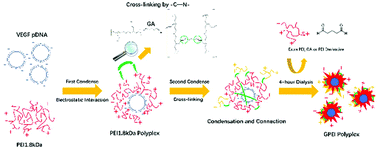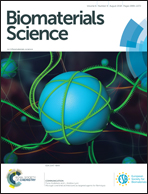One-pot construction of a twice-condensed pDNA polyplex system for peripheral nerve crush injury therapy†
Abstract
Non-viral vector gene delivery is generally limited by its potential toxicity problems, poor transfection abilities, serum stability, or relatively complex construction processes of modified polyplexes. Thus, we develop an efficient and stable polyplex system through convenient construction methods. Here, polyethyleneimine (PEI) 1.8 kDa and glutaraldehyde (GA) are used to construct a novel twice-condensed pDNA polyplex system using a one-pot construction method, including pH-responsive C![[double bond, length as m-dash]](https://www.rsc.org/images/entities/char_e001.gif) N linkages by which different PEI molecules on one single polyplex can link with each other. In this system, smaller particle sizes, higher zeta potentials and better serum stabilities are achieved without PEGylation or other chemical modifications using lyophobic segments, but via pH-responsive linkages that ensure the escape of nucleic acids. This polyplex system is used to deliver the pDNA of vascular endothelial growth factor (VEGF) whose half-life period in vivo is only around 30 minutes. Compared with polyplexes prepared using PEI 25 kDa, cells and rats treated with twice-condensed VEGF pDNA polyplexes express significantly more VEGF or myelin basic protein (MBP), and this new polyplex system showed fewer adverse effects in vitro and in vivo. In addition, revascularization and neurogenesis are also discovered in the rat sciatic nerve crush injury model.
N linkages by which different PEI molecules on one single polyplex can link with each other. In this system, smaller particle sizes, higher zeta potentials and better serum stabilities are achieved without PEGylation or other chemical modifications using lyophobic segments, but via pH-responsive linkages that ensure the escape of nucleic acids. This polyplex system is used to deliver the pDNA of vascular endothelial growth factor (VEGF) whose half-life period in vivo is only around 30 minutes. Compared with polyplexes prepared using PEI 25 kDa, cells and rats treated with twice-condensed VEGF pDNA polyplexes express significantly more VEGF or myelin basic protein (MBP), and this new polyplex system showed fewer adverse effects in vitro and in vivo. In addition, revascularization and neurogenesis are also discovered in the rat sciatic nerve crush injury model.



 Please wait while we load your content...
Please wait while we load your content...